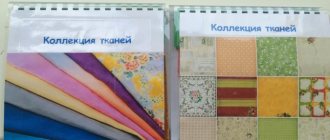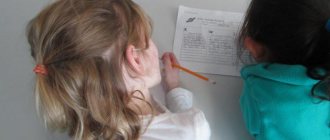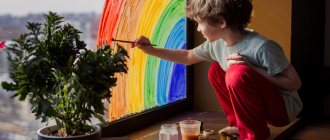Target:
continue to learn how to draw using the poking method, strengthen the ability to hold a brush; deepen ideas about color and geometric shapes (circle, oval, triangle); cultivate compassion and love for all living things.
Material and equipment
: landscape sheet with a pencil outline of a cat, brush, black, gray and green gouache, napkins, stands for brushes, sequins (for each child), easel, images of cats, envelope with a letter and sample, cat.
Drawing using the poke method with preschool children
One of the most important means of understanding the world and developing aesthetic perception is drawing.
Learning to draw in preschool age involves solving two interrelated problems: - It is necessary to awaken in children emotional responsiveness to the world around them, to the events of our lives; - To develop their visual skills and abilities.
By drawing, the child develops certain abilities: visual assessment of shape, orientation in space, sense of color. Special skills and abilities are also developed: eye-hand coordination, hand control. In addition, drawing classes bring joy to children and create a positive attitude. Therefore, developing methodological support for classes with children is an important and responsible task.
Many methodological techniques underlying the development of drawing skills are not without drawbacks. For example:
-A difficult task for preschool children will be the technique of depicting objects with thin lines, because... Due to their age, they have not developed graphic skills and abilities.
-The technique of coloring a picture using strokes or the filling method is also not aimed at preschool age. With this coloring, images of objects turn out to be monochromatic, flat, and when using watercolor paints, they are also transparent.
Such techniques make it difficult to adequately execute and perceive the drawing. I want to introduce you to the experience of learning to draw using the poke method.
Advantages of the poke method:
The proposed method: - allows you to develop special skills that prepare the child’s hand for writing; — makes it possible to experience the multi-colored image of objects, which is undoubtedly important for the most complete perception of the surrounding world; - forms an emotionally positive attitude towards the drawing process itself; - promotes more effective development of imagination and perception, and therefore cognitive abilities - drawings created using the poking method are aesthetically pleasing and understandable both to the child himself and to those around him.
When painting using the poke method, gouache is used, it should be thick, the brush should be hard, and most importantly dry.
The poke drawing technique for younger preschoolers is as follows: the teacher draws the outline of an object on the children’s sheet in advance with a simple pencil. Children first examine and trace with their finger the outline of a given object (an image of an animal, a bird), naming its parts out loud (head, ears, tail). Having started to draw, they should make pokes with a brush along the contour line from left to right, without leaving a gap between the pokes; then the surface inside the contour is painted with random pokes. Children draw the remaining necessary details of the drawing (eyes, nose, mustache, paws, etc.) with the end of a thin brush.
Children of senior preschool age should independently draw the contours of objects with a simple pencil or directly with a brush, using geometric shapes in different combinations. The painting technique is the same. In the process of painting with pokes, the drawn objects acquire a shape and volume close to real ones.
Methodological recommendations for drawing using the poking method.
1. Classes are held 1-2 times a month. 2. Gouache for classes should be thick. It is best to lay it out little by little in small sockets. 3. Paper can be used in any color and size. 4. There must be at least two brushes (one hard). 5. You also need a jar of water, a stand for brushes, a cloth napkin, and a simple pencil.
Before class, you can do a short exercise - warm-up with a brush:
Let's take the brush like this: Is it difficult? No, it's nothing. (The hand rests on the elbow, hold the brush with three fingers, above the metal part). Up - down, right - left (Perform movements with your hand). Proudly, like a queen, the brush poked and clicked with its heel. And then he walks in circles, like guys in a round dance. Are you tired? Let's rest and start knocking again. We draw: once, once... Everything will work out for us! (Put the brush vertically. Make a few pokes without paint).
As practice has shown, children like to draw this way and easily learn this method. As already noted, drawing with pokes stimulates the development of small muscles of the hand, so it is subsequently easier for children to master other methods of drawing.
Children's works using the proposed technique turn out to be interesting, expressive, colorful and delight both the little artists themselves and their parents.
Bibliography:
K.K. Utrobina, G.F. Utrobin. “Fun drawing using the poking method with children 3-7 years old”
Author: Mekhonoshina Anastasia Grigorievna, teacher, MBDOU No. 385 “Fairy Tale”, Ekaterinburg, Russia
The article is published in the author's edition
The importance of non-traditional drawing techniques for children's development in the garden
Unconventional drawing is interesting because children’s images always turn out different. As a rule, these are simple and accessible techniques, however, they play a very important role in the mental development of a preschooler. Their use presupposes an atmosphere of ease, allowing the child to take the initiative and express feelings and emotions in the drawing. The main thing in such activities is not the final product, but the formation of a self-confident personality.
The use of non-traditional techniques develops the research abilities of 4-5 year old children. After all, they provide the opportunity to experiment (for example, mix gouache with soap foam, apply paint to natural materials).
Non-traditional drawing improves the fine motor skills of middle group preschoolers, which in turn contributes to the development of correct speech.
Mental processes such as thinking, attention, visual memory, and imagination develop.
Tactile sensitivity increases - the fingertips are in direct contact with the paint, feeling its thickness and viscosity.
Working with unusual materials makes children wonder, improves their social and communication skills: children ask more questions to the teacher, to each other, their vocabulary is enriched and activated.
Class notes
| Author's full name | Title of the abstract |
| Druzhina E. | "Winter" (drawing in unconventional ways - imprinting with a cabbage leaf, image with cotton swabs) Educational objectives : learn to draw a landscape using unconventional techniques (printing with a cabbage leaf, painting with cotton swabs). |
| Kolesnikova I. | (in the middle group using the non-traditional poking method) Progress of the lesson: The lesson begins with a riddle about a bear. Then the teacher reads the fairy tale “Masha and the Bear”. Conversation on content: what Mishka did with Masha. Consider the structure of the bear, determine the shape of its head and body. The teacher demonstrates how to paint a bear figure using the poking method (the eyes and nose are glued on). Independent activity of children. Analysis of finished works. |
| Karpova I.N. | "Fish" (painting with palm and fingers) At the beginning of the lesson, the teacher organizes the game “Aquarium” (children perform actions according to the text):
Riddle about fish. Pictures of fish are considered. Conversation about where they live, what they eat, what helps them swim. Reading the poem “Fish” by I. Tokmakova. The teacher invites preschoolers to depict a fish in an unconventional way - using their palm. To do this, you need to lower your palm into a plate with gouache, and then make an imprint on a sheet of paper (with your thumb bent and the rest spread out). Actions must be performed quickly, otherwise the paint may have time to dry. Near the fish, it is advisable to depict a background - pebbles (painting with fingers) and algae (painting with a brush). After the children’s independent activities, a physical education session called “Fish” is held. An exhibition of works is held: the guys explain where each fish swims and choose the most beautiful of them. |
| Zotkina O.K. | "Scarlet Sails" (drawing with sand and paints) The kindergarten is located in the resort town of Evpatoria, so sand painting is very relevant in this case. At the beginning of the lesson, the teacher reads V. Orlov’s poem “I draw the sea” to the children. A conversation is held about their hometown, which tourists also call the city of the Sun, the city of Childhood. This is due to the fact that Evpatoria has a lot of sunny days a year, an unusually gentle sea, and there is also a huge number of children's health centers and camps. The teacher reminds the children that they were at sea today and asks what they remember most (warm sand and pleasant water, bright sun, beautiful shells, ships, boats). The teacher invites preschoolers to draw a ship with scarlet sails, a bright sun and their favorite sea. And sand brought from the beach will help to do this. A physical education session on the marine theme “Sea” is being held.
Examination of a sample and explanation of image techniques. The sand needs to be sifted to remove shells and other impurities. Using a simple pencil, the contours of the ship, the sun and the sea are drawn, onto which glue is then generously applied. Sand is scooped up into a pinch and sprinkled onto the contours of the image. The excess is poured into a plate. Next, the sails are covered with scarlet paint so as not to touch the sand. The sun, sky and sea are also painted. The guys begin to work to relaxing music (sounds of the sea and the sound of the surf). |







